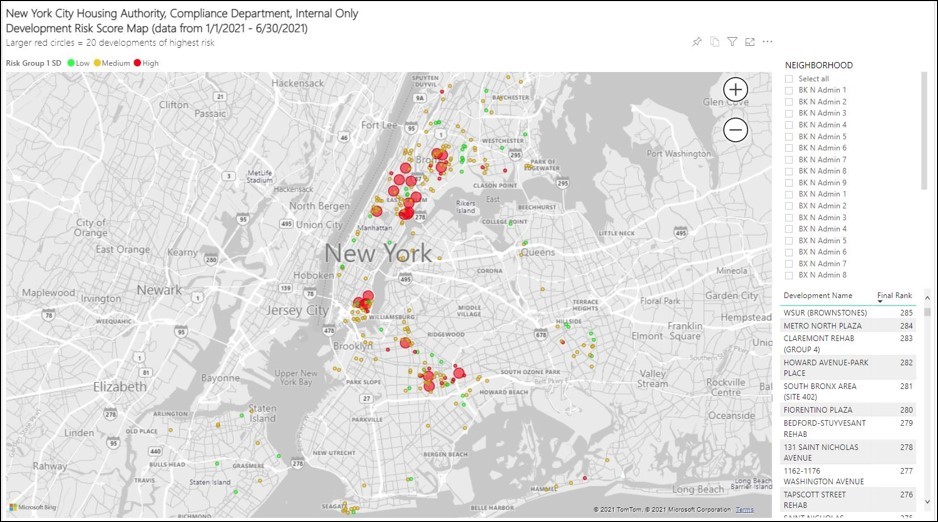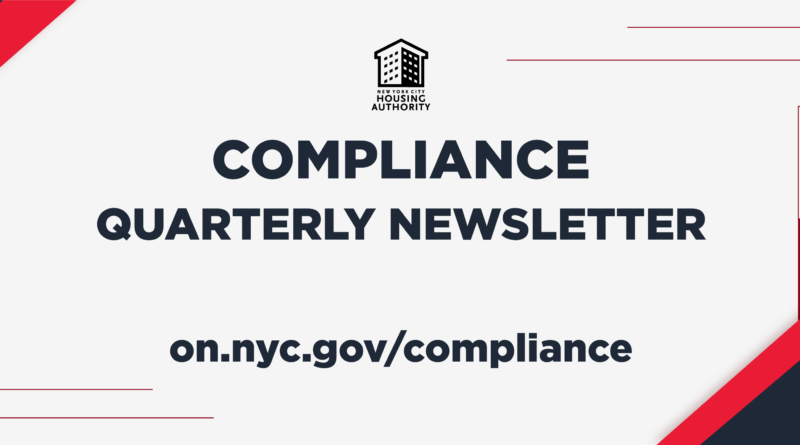Inspiring a Compliance Culture
Read the Compliance Department’s Quarterly Newsletter
Development Risk Scoring Assessment
Background
Compliance with federal, state, and local laws and regulations and NYCHA’s standard procedures (SP) is vital to NYCHA’s mission to provide safe and affordable housing to its residents. To help meet this goal, the Compliance Integration Reporting and Evaluation (CIRE) Unit in the Compliance Department, in collaboration with the Performance Tracking and Analytics Department (PTAD), created a Development Risk Scoring Assessment. This useful tool measures which developments are at the greatest risk for non-compliance with the 2019 HUD Agreement; federal, state, and local laws and regulations; and NYCHA’s SPs. The assessment tracks the development performance of many key indicators, and the Monitoring Unit in the Compliance Department uses it to choose the developments where they will perform on-site monitoring.
Indicators and Scoring Process
The Development Risk Scoring Assessment ranks developments based on 27 indicators that cover six major areas addressed in the 2019 HUD Agreement: Annual Inspections, Elevators, Heat, Lead, Mold, and Pests. The indicators include average time to complete heat or hot water outages, number of violations per 100 dwellings, rent collection rate, and annual inspection completion rate. Each development is ranked against all other developments for each indicator, and receives a final score based on its average rankings across all indicators. From here, each development is classified into a high, medium, or low risk level for non-compliance.
Development Risk Scoring Dashboard and Map
The assessment results can be seen on the Development Risk Assessment Dashboard and Map on the Compliance webpage. The dashboard shows detailed information on each development’s rankings and indicator scores. The dashboard also shows any change in score from the previous assessment, and can be filtered by borough, consolidation, and neighborhood administrator area. In addition to the dashboard, the CIRE Unit created the Development Risk Assessment Map to show the assessment results. As shown below, the map displays NYCHA developments at a high risk level in red, medium risk level in orange, and low risk level in green, with the top 20 highest risk developments highlighted with large red circles. Like the dashboard, the map can be filtered by neighborhood areas.

Compliance Advisory Alerts
During the past quarter, the Compliance Department posted several Advisory Alerts to bring attention to important compliance issues and to remind staff of their responsibilities to address these issues. Please read the alerts in full. The key takeaways from two recently published Advisory Alerts are described below:
Expired Pesticides
Compliance Advisory Alert #20 reminds staff that expired pesticides must be disposed of properly by actively managing pesticide inventory to avoid overstocking and waste. Supervisors of exterminators (SOE) must properly track pesticide inventory using NYCHA Form 088.193, Exterminator Shop Inventory. When inventory is low, the SOE informs the property maintenance supervisor to purchase the necessary product. Expired pesticides must be disposed of as outlined in SP 040:09:6, Pest Prevention and Control in NYCHA Residential Buildings.
Responsibilities related to the disposal of expired pesticides include:
- Exterminators must contact the SOE to report expiring pesticides at least one month prior to the expiration date, or as soon as it is noticed.
- The SOE must email the Pest Control Department’s Technical Advisors to arrange pesticide removal.
- An SOE or licensed exterminator must be present when the vendor removes the expired pesticide.
Vendor Certifications/Licenses – Mold and Renovation, Repair, and Paint (RRP) Work
Compliance Advisory Alert #21 is a reminder that property management staff must always confirm that vendors and all vendor staff have the appropriate certification(s) prior to performing mold and/or renovation, repair, and paint (RRP) work at NYCHA developments. Note that some work tickets require firms and workers to have both mold and RRP certifications.
For mold-related work, each vendor is required to hold a valid New York State Mold Remediator Company License, and vendor staff are required to hold a valid New York State Mold Abatement Worker License. For RRP-related work, each vendor is required to hold a valid EPA RRP Company Certification, and vendor staff are required to hold a valid EPA RRP Individual Certification.
The property manager (PM), property maintenance supervisor (PMS), or assistant property maintenance supervisor (APMS) must receive copies of the required documents before the vendor begins work. While onsite, the PM, PMS, or APMS must confirm that vendor staff have a physical or electronic copy of their valid certification(s), and that they write their name and certification identification number in the vendor logbook. Please read SP 040:14:1, Mold/Mildew Control in NYCHA Residential Buildings, and SP 050:20:1, Lead Safe Housing Procedure for full instructions on mold and RRP work and vendor certifications.
Conclusion
The Compliance Department will continue working with our colleagues to ensure that NYCHA is a safe and healthy place for our residents, employees, and vendors. If you have any concerns or complaints, you can make a confidential and anonymous report by calling the Customer Contact Center at (718) 707-7771 (select menu option 7) or by visiting the Compliance Department section of NYCHA’s website. Complaints also can be reported to any other federal, state, or local government entity. Remember, the Compliance Department is here to help.
90 Church Street
New York, NY 10007
https://on.nyc.gov/submit-concern







